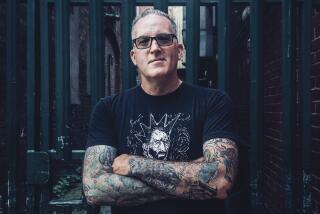Review: ‘The Man Who Couldn’t Stop’ a rich, reasonable look at OCD
- Share via
Has the thought of swerving your car into oncoming traffic ever popped into your head? What about the thought of a stranger, nude? Or sliding a knife into someone’s gut? As David Adam reports in “The Man Who Couldn’t Stop: OCD and the True Story of a Life Lost in Thought,” “nine in ten people experience thoughts that distress, bewilder, shock, and perplex them.”
Most of us brush them off, move on with our lives. But for some, intrusive thoughts remain and begin to drive compulsive behaviors, mushrooming into the mental illness known as obsessive-compulsive disorder.
Adam, a writer and editor at the science journal Nature, layers science, history and a slim but disarmingly candid account of his own experience with OCD into a compelling portrait of the disorder, from onset to treatment. He traces links between OCD, schizophrenia, hoarding, sociopathy, autism and even religious ritual and belief. We begin to see OCD in relation to what is considered normal human behavior, such as daydreaming and the rituals invented by children, suggesting that OCD may be the exaggerated expression of certain traits more or less apparent in all of us.
A sure-footed and lucid guide, Adam leads us through Freudian psychology (“Freud said that OCD was down to repressed guilt about childhood masturbation. Thanks, Sigmund”), evolutionary psychology, genetics, neurobiology, philosophy, anthropology and even zoology. Psychological studies have shown onset can often be traced to trauma; neurobiologists point to dysfunction in a processing loop that includes the basal ganglia; animal studies show compulsive behaviors are not limited to humans.
“The Man Who Couldn’t Stop” could easily get bogged down by jargon and theory, but Adam’s voice is earnest and self-aware, punctuated by moments of wry humor. Fascinating case histories, both famous and not, help keep the pace brisk. We hear about people like Samuel Johnson, Martin Luther, Hans Christian Anderson and Mademoiselle F, the patient zero of OCD from the turn of the 19th century. She was so troubled by the thought she might steal something that she withdrew from society, established elaborate counting and washing rituals and “wore her shoes so tight that the skin from her swollen feet gathered in bunches above, to keep her from placing stolen items inside.”
The result is a rich and unblinkingly reasonable portrait of a mental illness whose hallmark may be irrationality. For Adams, who came of age in the ‘80s, the irrational thought was: “What if I have AIDS?” He knew the chances were infinitesimal, but no matter how hard he tried to ignore it, the threat — the thought — was omnipresent. “My stream of consciousness had a taut net strung across it, a net just big enough to trap one misshapen irrational thought at a time… the net was always full.” The only way to relieve the anxiety caused by these thoughts was to check that he hadn’t contracted the disease.
With clear-eyed candor, Adam describes seeking reassurance by compulsively calling the National Aids Helpline and checking towels, doorknobs and clothing for signs of blood. (A person with OCD can spend up to 10 hours a day on obsessive thoughts and compulsive behaviors.) Of course, he could never be absolutely certain he had not, through some supremely unlucky fluke, contracted the disease. In this way, OCD can be seen as a disorder of doubt — learning to live with OCD is learning to live with uncertainty.
This book sometimes displays a surprising lack of nuance (on taking drugs to treat his OCD: “I don’t see any downside”), but these moments are counter-balanced by a more subtle overarching argument. All these case histories and fascinating links lead to a grander plan made explicit in the final chapters. Here, Adam argues we scrap the “categorical approach” to mental illness driven by the DSM, the diagnostic bible of psychiatric conditions, in favor of a more complex “dimensional approach” that scores symptoms on a sliding scale. The category approach insists on solid boundaries between mental disorders, “viewed as discrete conditions to be diagnosed and treated separately.” But these boundaries have proved porous and modern science has generally failed to find the distinctive biomarkers that would set these categories apart on a biological basis. “The categories of the DSM probably don’t reflect the situation on the ground. They may not exist at all.”
Worse, argues Adam, the category approach stymies understanding of mental illness and the discovery of new treatments. To win drug approval, clinical trials recruit subjects based on DSM categories — depression, OCD, bipolar — as if they are “separate species.” This obscures the relationships among people sifted into separate categories as well as whitewashing differences within categories. “It’s not just the DSM that is tied to the flawed category approach to mental illness, it’s the entire scientific and medical system. Panels that award research grants to scientists and journal editors who decide what to publish, all tacitly support and follow it. They endorse it, even though many of them know it doesn’t work and isn’t based on science.” Strong words, coming from an editor at Nature.
Adam may not be the first to make this argument, but this is the most comprehensive and compassionate book on OCD to date, and it offers hope that our thinking and behavior — both individual and collective — can change.
Crist is writer-in-residence in Biological Sciences at Columbia University and editor-at-large at Nautilus.
The Man Who Couldn’t Stop
OCD and the True Story of a Life Lost in Thought
David Adam
Sarah Crichton / Farrar, Straus and Giroux: 336 pp., $26
More to Read
Sign up for our Book Club newsletter
Get the latest news, events and more from the Los Angeles Times Book Club, and help us get L.A. reading and talking.
You may occasionally receive promotional content from the Los Angeles Times.






